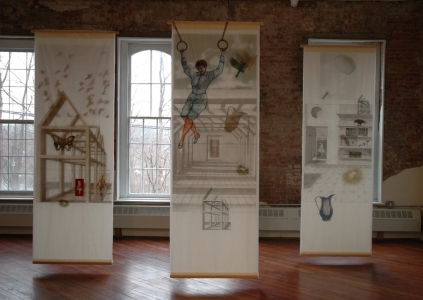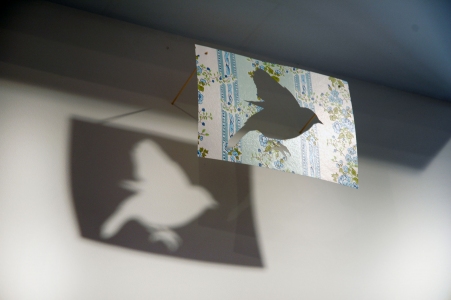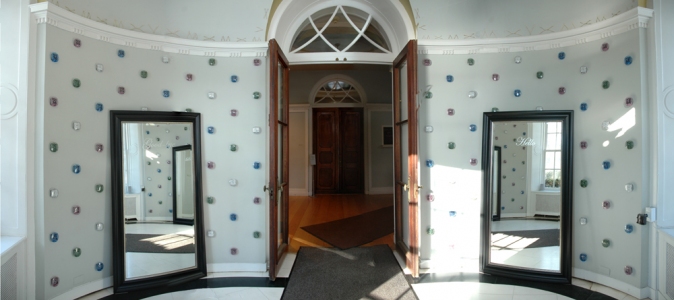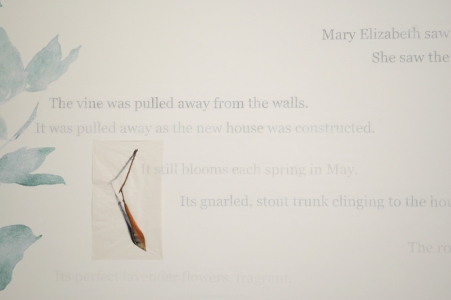Pentimenti Drawings. 2009-11.
(3 panels, 39"X9')
Gouache, charcoal, pencil, archival ink jet prints on Japanese gampi paper.
Each drawing is comprised of three sheets of translucent paper hung adjacently so that the compositions, viewed from two sides, are affected by the traces of drawings and prints from the underlying sheets. . "Pentimento" in Italian literally means regret, and it's a term used in painting when compositional elements covered over by the artist during the production of a painting become visible again over time, as the top layers of paint sometimes become translucent with age. The artist's corrections and changes may reappear at a later date as testament to her process, much like the way memory emerges over time, bearing witness to our lives.
The project was inspired by an historical system for memorization called the "memory palace" in which one created a fictional building, placing memories in each room as a way of associating the memories to specific locations to order and to recall them. But memory is a process as much re-created as recollected. And, so, the three layers in each drawing are thin and fragile and shift with air currents, causing images from the underlying sheets to move in and out of focus. Images foregrounded on one side may become mere shadows when viewed from the other. So, although these drawings, like "memory palaces," reference architecture as an organizing principle, the multiple layers and shifting focus resist closure suggesting, instead, a sense of memory as provisional and contingent.
(3 panels, 39"X9')
Gouache, charcoal, pencil, archival ink jet prints on Japanese gampi paper.
Each drawing is comprised of three sheets of translucent paper hung adjacently so that the compositions, viewed from two sides, are affected by the traces of drawings and prints from the underlying sheets. . "Pentimento" in Italian literally means regret, and it's a term used in painting when compositional elements covered over by the artist during the production of a painting become visible again over time, as the top layers of paint sometimes become translucent with age. The artist's corrections and changes may reappear at a later date as testament to her process, much like the way memory emerges over time, bearing witness to our lives.
The project was inspired by an historical system for memorization called the "memory palace" in which one created a fictional building, placing memories in each room as a way of associating the memories to specific locations to order and to recall them. But memory is a process as much re-created as recollected. And, so, the three layers in each drawing are thin and fragile and shift with air currents, causing images from the underlying sheets to move in and out of focus. Images foregrounded on one side may become mere shadows when viewed from the other. So, although these drawings, like "memory palaces," reference architecture as an organizing principle, the multiple layers and shifting focus resist closure suggesting, instead, a sense of memory as provisional and contingent.
Improbable Spring. 2008.
Dimensions variable.
Gouache, archival inkjet prints, beeswax on mulberry paper; "found" wallpaper, wood, plastic, audio components.
This installation was a response to my father's death, the images of robins inspired by a game we played each spring as to who would spot the first bird of the season. The robin, historically associated with rebirth, also relates -- through juxtaposition -- to temporality, loss, and memory. I hand-wrote texts onto the walls of the gallery examining aspects of memory and loss, while panels of "found" floral wallpaper sheets carried associations to spring, home, and the family. The walls were activated by light moving through the cut-out shapes in the wallpaper to form silhouettes of the birds upon their surfaces -- present and, yet, intangible.
Brightly painted robins superimposed upon digital prints of nests, trees, bird watchers, houses, people on stilts, and gymnasts were layered in the gallery windows to create a "landscape" of birds. The gymnasts, their images tightly cropped and arms outstretched, seem as if they are trying to fly, while the bird watchers, looking up to the clouds, almost always miss the birds. The people on stilts never touch the ground, trying to defy the weight of their bodies. An audio of robin calls intermittently disrupted the silence of the gallery.
Dimensions variable.
Gouache, archival inkjet prints, beeswax on mulberry paper; "found" wallpaper, wood, plastic, audio components.
This installation was a response to my father's death, the images of robins inspired by a game we played each spring as to who would spot the first bird of the season. The robin, historically associated with rebirth, also relates -- through juxtaposition -- to temporality, loss, and memory. I hand-wrote texts onto the walls of the gallery examining aspects of memory and loss, while panels of "found" floral wallpaper sheets carried associations to spring, home, and the family. The walls were activated by light moving through the cut-out shapes in the wallpaper to form silhouettes of the birds upon their surfaces -- present and, yet, intangible.
Brightly painted robins superimposed upon digital prints of nests, trees, bird watchers, houses, people on stilts, and gymnasts were layered in the gallery windows to create a "landscape" of birds. The gymnasts, their images tightly cropped and arms outstretched, seem as if they are trying to fly, while the bird watchers, looking up to the clouds, almost always miss the birds. The people on stilts never touch the ground, trying to defy the weight of their bodies. An audio of robin calls intermittently disrupted the silence of the gallery.
Janus Doorway. 2007-08.
Dimensions variable.
Alarm clocks, mirrors, wish bones, spray paint, watercolor paint, audio.
Installed at the Wave Hill House in Wave Hill, Bronx, NY.
This site-specific piece, installed in the foyer of the Wave Hill House, referenced the two-faced Roman god of time, who looks simultaneously at both past and future. The installation included 84 alarm clocks and 172 wishbones, detailing architectural elements of the historic space. Foregrounding visitors’ actions of arriving and leaving, the piece emphasized the doorway as a liminal place of transition. An audio component explored traditions and rituals marking the cyclical passage of time, referencing resolutions, wishes, and memories. By making viewers aware of their movements “coming” and “going” through the foyer, the installation encouraged them to become more aware of their movement through time.
Dimensions variable.
Alarm clocks, mirrors, wish bones, spray paint, watercolor paint, audio.
Installed at the Wave Hill House in Wave Hill, Bronx, NY.
This site-specific piece, installed in the foyer of the Wave Hill House, referenced the two-faced Roman god of time, who looks simultaneously at both past and future. The installation included 84 alarm clocks and 172 wishbones, detailing architectural elements of the historic space. Foregrounding visitors’ actions of arriving and leaving, the piece emphasized the doorway as a liminal place of transition. An audio component explored traditions and rituals marking the cyclical passage of time, referencing resolutions, wishes, and memories. By making viewers aware of their movements “coming” and “going” through the foyer, the installation encouraged them to become more aware of their movement through time.
Memento (If These Walls Could Talk).
2006. Dimensions variable.
Gouache and archival ink jet prints on paper, acrylic and latex paint.
Installed: Glyndor Gallery at Wave Hill, Bronx, NY.
Invited to develop an installation addressing the theme of "survival," I focused on the history of the Glyndor Gallery building and its environment to create a site-specific work emphasizing the importance of memory to our existence. My goal was to mark the history of the site, to render it visible to the viewer and, by doing so, to locate the viewer in the present moment as part of the dynamic continuum linking past and future.
After researching the history of the site as a private estate and, then, public garden from the mid 1800's to the present, I became interested in the Chinese wisteria vine that surrounds the building today -- a plant that is over 100 years old and has survived three reconstructions. I painted life-size silhouettes of the vine directly onto the gallery walls and attached gouache paintings of wisteria seed pods throughout the space. I embedded texts into the walls, suggesting simultaneous frames for perceiving the history of the place: these referenced the personal, cultural, biological, and geological.
I was interested in establishing a sense of time and history as comprised of interwoven "events" as the texts, shifting in tones from light to dark grey evoked a series of whispering "voices" emerging from the walls, encouraging viewers to make connections between the current environment and its history.
2006. Dimensions variable.
Gouache and archival ink jet prints on paper, acrylic and latex paint.
Installed: Glyndor Gallery at Wave Hill, Bronx, NY.
Invited to develop an installation addressing the theme of "survival," I focused on the history of the Glyndor Gallery building and its environment to create a site-specific work emphasizing the importance of memory to our existence. My goal was to mark the history of the site, to render it visible to the viewer and, by doing so, to locate the viewer in the present moment as part of the dynamic continuum linking past and future.
After researching the history of the site as a private estate and, then, public garden from the mid 1800's to the present, I became interested in the Chinese wisteria vine that surrounds the building today -- a plant that is over 100 years old and has survived three reconstructions. I painted life-size silhouettes of the vine directly onto the gallery walls and attached gouache paintings of wisteria seed pods throughout the space. I embedded texts into the walls, suggesting simultaneous frames for perceiving the history of the place: these referenced the personal, cultural, biological, and geological.
I was interested in establishing a sense of time and history as comprised of interwoven "events" as the texts, shifting in tones from light to dark grey evoked a series of whispering "voices" emerging from the walls, encouraging viewers to make connections between the current environment and its history.







